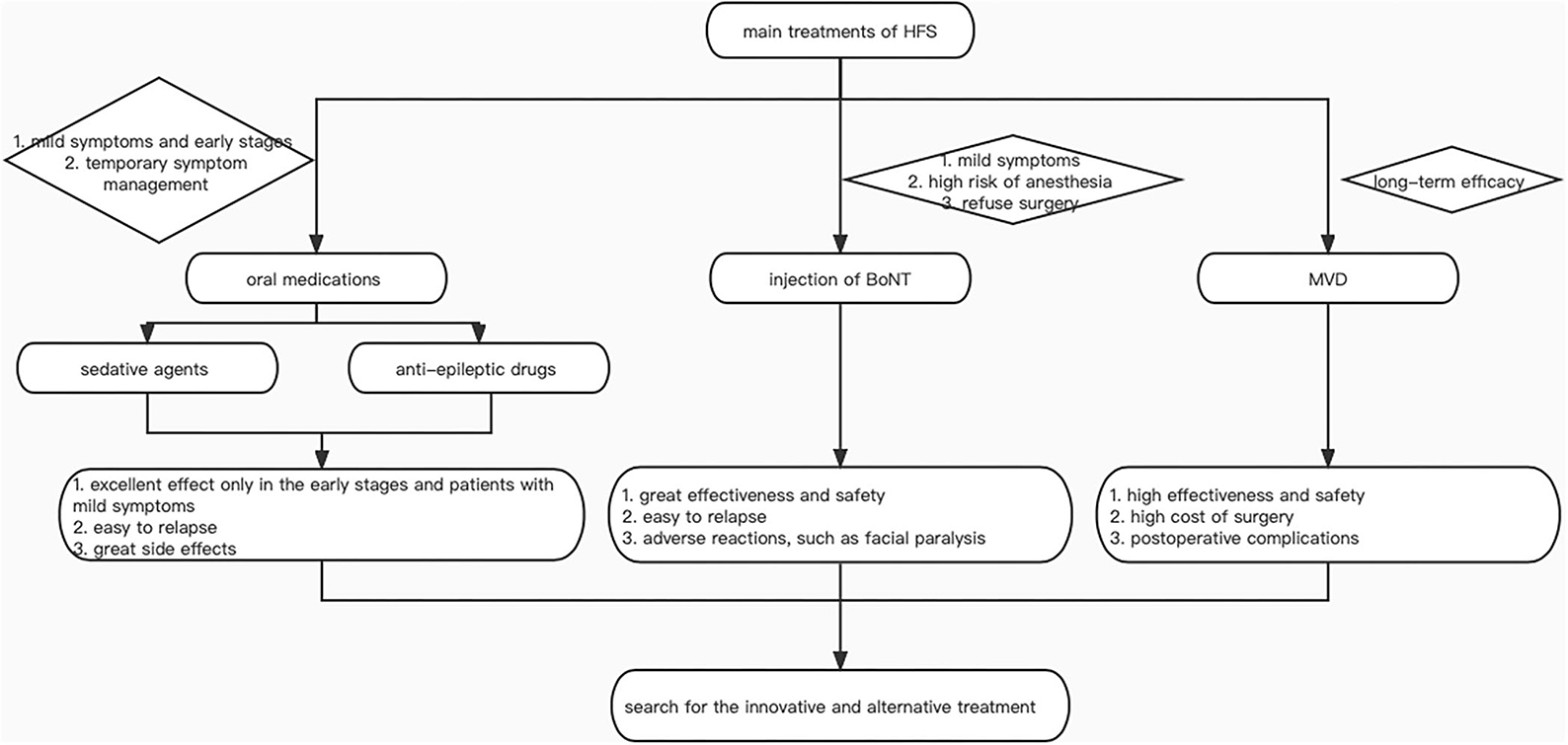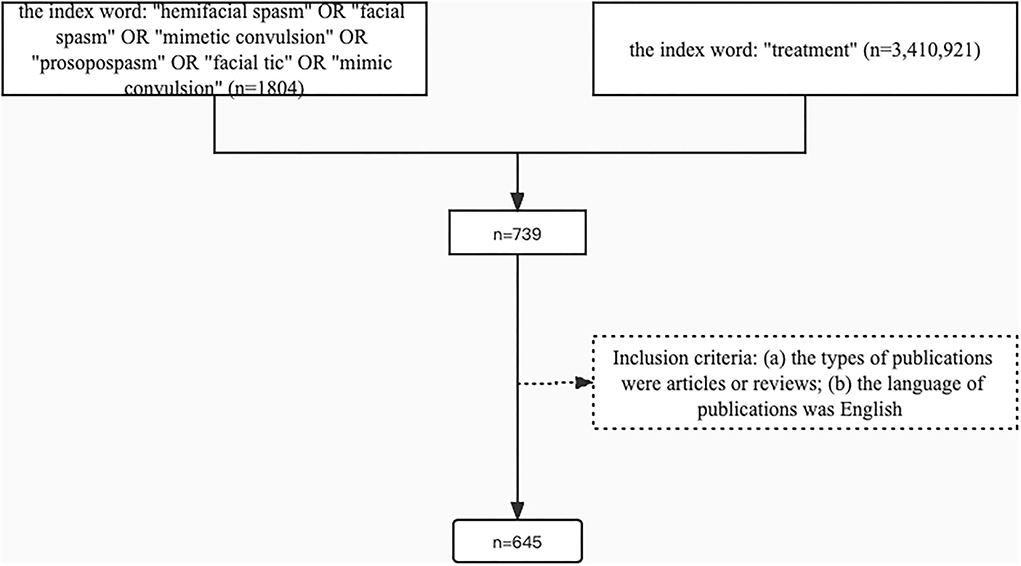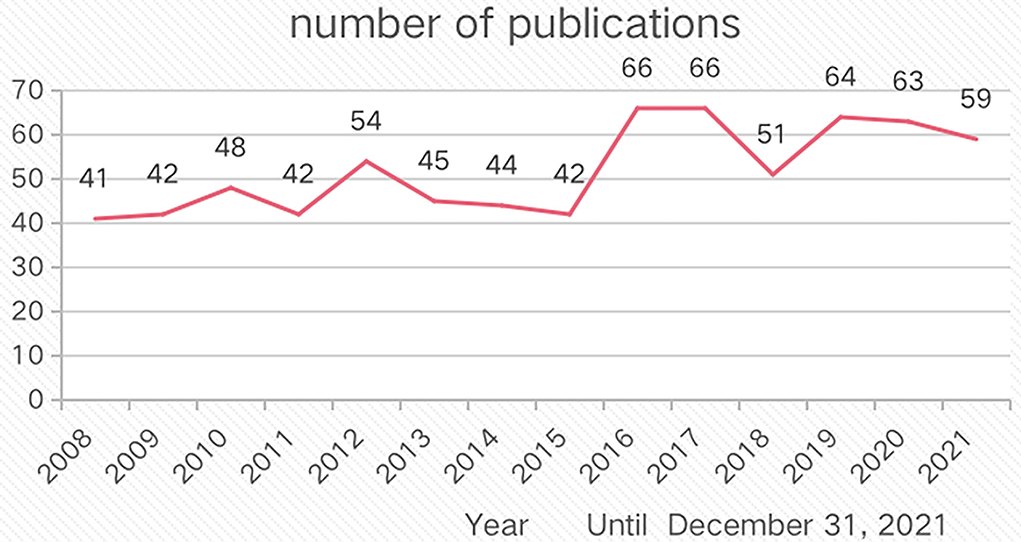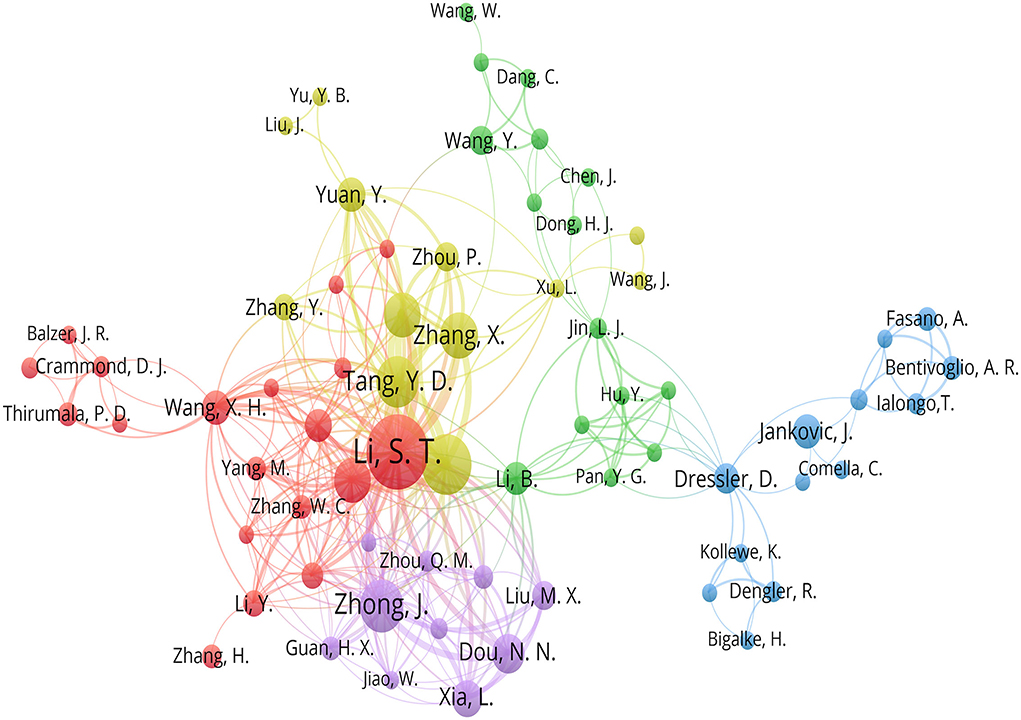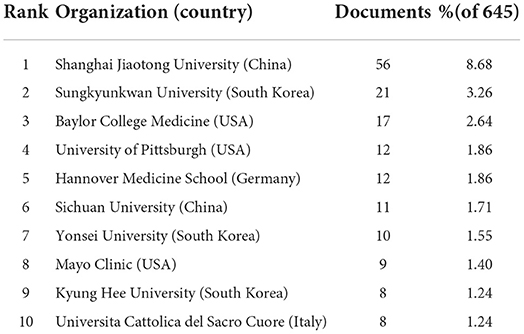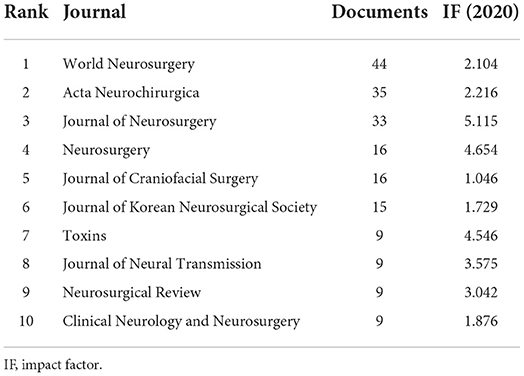- 1The Third Clinical College of Zhejiang Chinese Medical University, Hangzhou, China
- 2Department of Acupuncture, Third Affiliated Hospital of Zhejiang Chinese Medical University, Hangzhou, China
Objective: Hemifacial spasm (HFS) is a common neurological disorder of the brain, which is difficult to treat. Most patients are distracted by it and are unable to work or study normally, which seriously affects their physical and mental health. However, there are a few bibliometric studies on it. This paper searched the articles on HFS using a bibliometric approach.
Method: Articles about HFS were retrieved from the Web of Science (WoS) Core Collection database. We employed the Visualization of Similarities (VOS)viewer to analyze these publications.
Results: A total of 645 reviews or articles in English were retrieved from WoS. In this study, we found that the number of publications showed a rising trend and China is the most active in searching the treatment of HFS. About keywords, neurosciences and neurology was searched (422 times) keyword, followed by hemifacial spasm (420 times) and surgery (320 times). By assessing the organizations, Shanghai Jiao Tong University published the most papers (8.68%), followed by Sungkyunkwan University (3.26%) and Baylor College Medicine (2.64%). A total of 247 journals have delivered publications on the treatment of HFS, World Neurosurgery (44 papers) published the largest number of articles.
Conclusion: The annual publications have increased with a fluctuating tendency. More researchers were taking an interest in HFS. This study helped us find out the hotspot and trend in research about facial spasm treatment.
Introduction
Hemifacial spasm (HFS) is a common neurological disorder of the seventh cranial nerve characterized by the involuntary twitching or contractions of the facial muscles (1), seriously, difficulty in opening eyes, mouth deviation, tinnitus, and so on. In most cases, HFS's etiology is the facial nerve compressed by vessels in the pontocerebellar horn region, rare cases are caused by malignant tumors, inflammation, or others (2). About 30% of patients with peripheral facial palsy are left with sequelae, one of which is facial muscle spasm (3). Some scholars (4, 5) hold the opinion that a measure of vascular compression causes demyelination of the nerve root, inducing transmembrane sodium channels on the axon; under a number of trigger factors, such as transient fluctuations in blood pressure or pulse, these voltage-gated channels reach the threshold and eventually generate conductible action potentials from the damaged nerve. In addition, HFS affects ~10 per 100,000 people, mainly women, with a peak age of 40–50 years old (6). This disease makes patients anxious and depressed, affecting the quality of their life.
There are two types of HFS: typical facial spasm and atypical spasm. A typical facial spasm is a spasm that starts in the eyelids and progresses downward to the lower facial muscles, such as the expression muscles of the cheek, whereas an atypical facial spasm is a spasm that starts in the lower facial muscles and progresses upward to the eyelids and frontalis. Atypical facial spasms are uncommon in clinical practice (7).
In clinical practice, for the treatment of HFS, there are drug therapy, injections of Botulinum Toxin (BoNT) (8), microvascular decompression (MVD) (9), and so on. It is known that medication is useful for early improvement of symptoms, but long-term curative effects are poor, BoNT is the most commonly used non-operative treatment for HFS, while MVD is a safe and effective treatment for it through removing the offending artery from the facial nerve with a good exposure to relieve spasm (10, 11) (Figure 1). Nevertheless, rare bibliometric analyses focus on the treatment of HFS and there is not a systematic cognition of it.
Bibliometric analysis is a quantitative way to analyze a large number of studies using mathematical and statistical tools in special areas (12). Li et al. (13) did a bibliometric analysis on neuropathy and Goo et al. conducted a research on facial palsy using the bibliometric method (14). Zhang et al. utilized the bibliometric method to know more about acupuncture for analgesia (15). Wang et al. wrote an article about Middle East Respiratory Syndrome using Visualization of Similarities (VOS)viewer (16).
This study aimed to employ a bibliometric analysis on the treatment of HFS via VOSviewer to learn about the trends and hotspots.
Materials and methods
Data collection
All data retrieval was based on the Preferred Reporting Items for Systematic reviews and Meta-Analyses (PRISMA) protocol (Figure 2), the documents were acquired from the Web of Science (WoS) database from inception to 23 April 2022. The retrieval strategy included 3 parts. Part 1: we searched the articles using the words “hemifacial spasm,” “facial spasm,” “mimetic convulsion,” “prosopospasm,” “facial tic,” and “mimic convulsion.” There were 1,804 records by this query. Part 2: we retrieved the articles using “treatment” as the index word, then 3,410,921 records were shown. Part 3: we combined two queries to focus on the treatment of HFS all this time. Ultimately, 739 articles were analyzed.
Inclusion criteria: (a) the types of publications were articles or reviews and (b) the language of publications was English. Finally, 645 articles were retrieved to conduct the bibliometric analysis.
Analysis tool
Visualization of Similarities (VOS)viewer (version 1.6.18, Leiden University, Leiden, The Netherlands) was used to construct and visualize the bibliometric networks in this study. The program provides a viewer with a comprehensive and detailed examination of bibliometrics. For example, these networks may include journals, researchers, or individual publications, which may be constructed on the basis of citations, bibliographic coupling, co-citation, or co-authorship relationships (17). In the visualization using the VOSviewer, the attraction/repulsion values in the layout items were all set with attraction, 3/repulsion, −2 for clearer presentations.
Results
Analysis of annual publications
There were no relevant papers prior to 2008. Until 31 December 2021, the number of annual publications was fluctuating, but a gradual upward trend from only 41 in 2008 to 59 in 2021 (Figure 3).
Analysis of authors
The 645 articles were written by 2,592 authors. In terms of the number of articles published, the top three most prolific authors were as follows: Li S. T. (45 publications), Zhu J. (29 publications), and Zhong J. (23 publications). The links among these articles are shown in Figure 4.
Analysis of countries
With regard to the countries of the published literature related to the treatment of HFS, the top 10 most active countries are shown in Table 1. Furthermore, Figure 5 reveals the average publication year among these countries. The most prolific country was China, followed by the USA and South Korea.
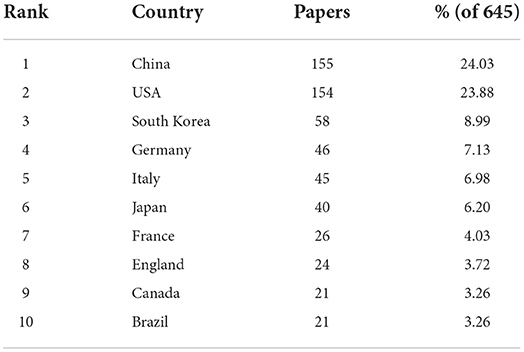
Table 1. The top 10 countries that published the literature on the treatment of hemifacial spasm (HFS).
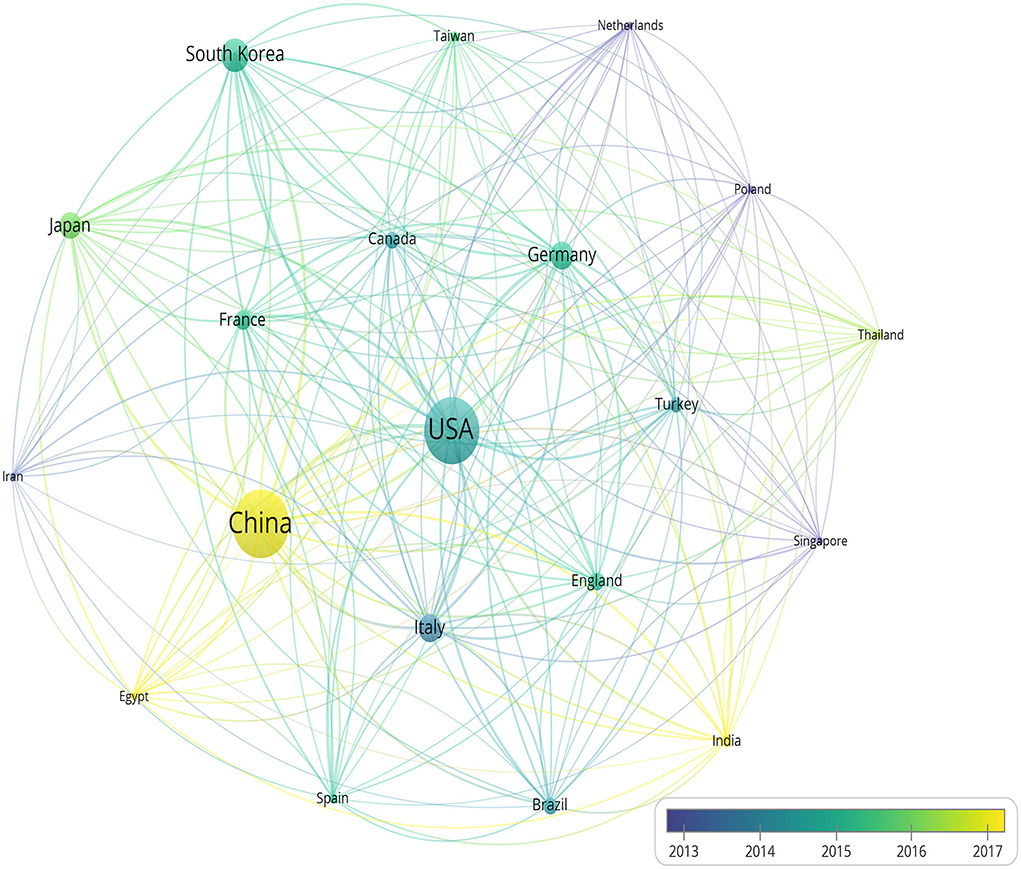
Figure 5. The map shows the average publication year of countries with yellow standing for later and purple standing for earlier.
Analysis of keywords
Before analyzing the terms of the 645 articles, we created a thesaurus file so that some terms could be unified into 1 term. For example, “microvascular decompression,” “MVD,” and “decompression” were unified as “microvascular decompression surgery” and “stereotactic radiosurgery,” “gamma-knife radiosurgery,” and “surgical-treatment” were all unified as “surgery.”
In total, 85 keywords out of the 2,499 terms were analyzed when we set “10” as the minimum occurrence of them. They were classified into 4 clusters with different colors according to the frequency (Figure 6A). Cluster 1 almost represented clinical studies; the frequency of hemifacial spasm was 420 times, followed by botulinum toxin (163 times). Cluster 2 represented clinical therapy; the most frequent term was management (69 times). Cluster 3 represented the etiology and operative treatment of HFS, the most frequent word was neurosciences and neurology (422 times), followed by surgery (320 times), microvascular decompression surgery (277 times), and trigeminal neuralgia (144 times). Cluster 4 represented pathogenesis consisting of abnormal muscle response, ephaptic transmission, lateral spread response, etc., series and term follow-up were the most frequent terms (38 times).
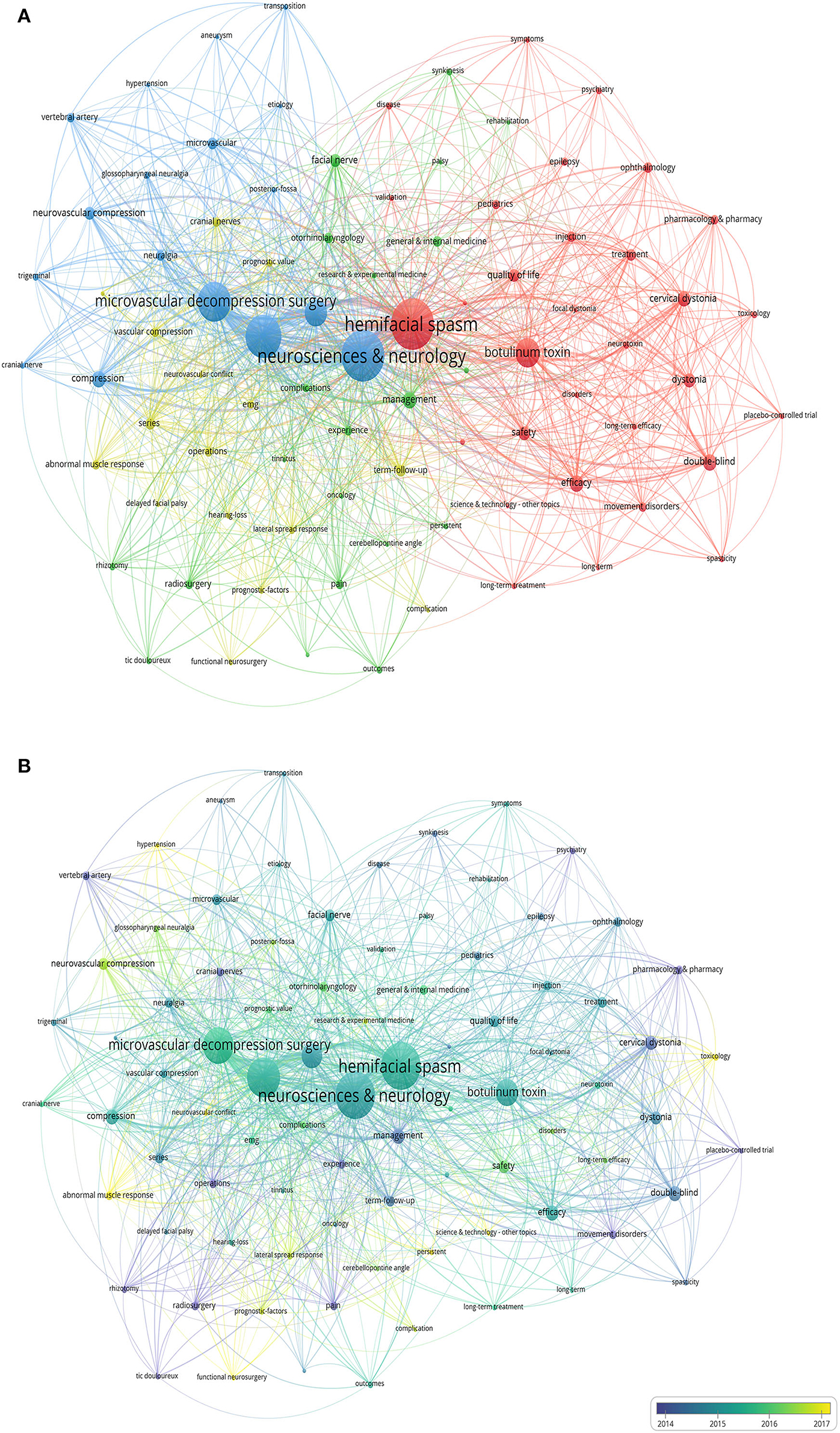
Figure 6. (A) The frequency of keywords in the published articles on the treatment of hemifacial spasm (HFS). (B) The map shows the average publication year of keywords with yellow standing for later and purple standing for earlier.
Figure 6B shows the keywords according to the average year of publications. Purple represents the keywords mentioned earlier while yellow represents later. Overall, treatment of HFS tends to be more scientific and cautious focusing more on pathogenesis and nature of the disease.
Analysis of organizations
There were 832 organizations of 645 pieces of literature. We set “5” as the minimum documents of an organization, then 22 institutions were analyzed. The top 10 most productive organizations are shown in Table 2. Although the most productive institution was in China, eight out of 10 institutions were from other countries, such as South Korea, the USA, Germany, and Italy.
Analysis of journals
In total, 247 journals have delivered publications on the treatment of HFS. The 20 journals were finally extracted by setting “7” as the minimum number of documents of a source. Figure 7 shows the average publication year of 20 journals. Table 3 displays the top 10 most prolific journals on the treatment of HFS.
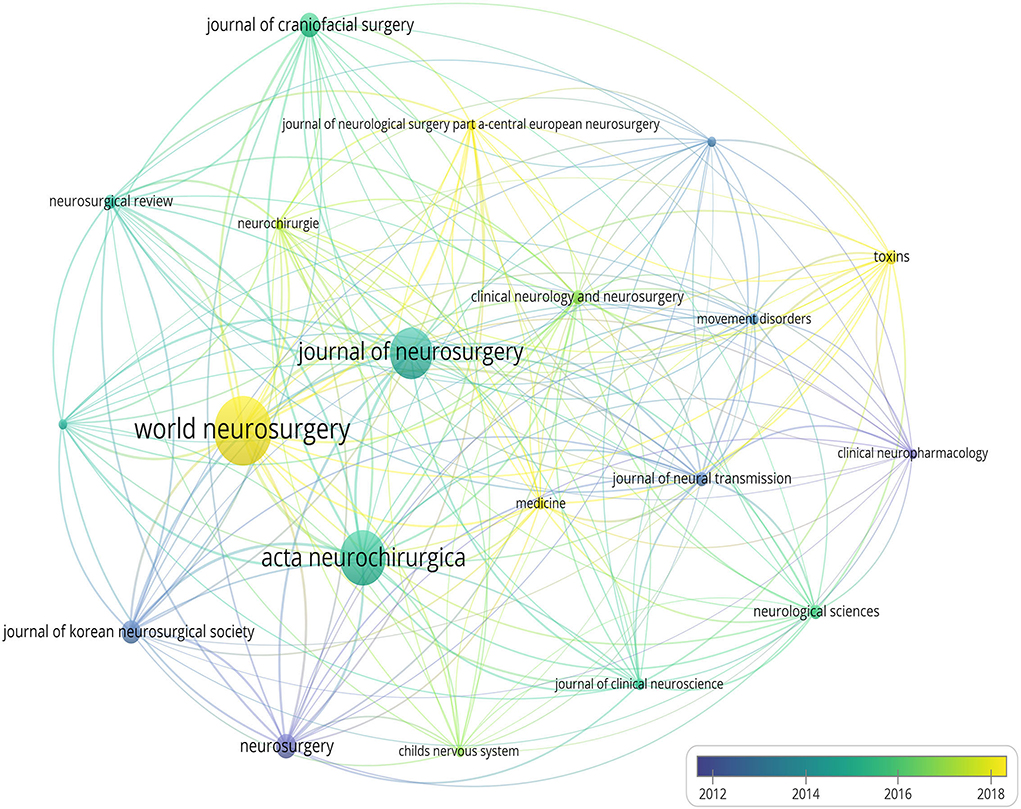
Figure 7. The map shows the average publication year of 20 journals with yellow standing for later and purple standing for earlier.
Discussion
The bibliometric analysis revealed that more researchers were concerned about the therapy of HFS. Recently, some investigators delivered articles about MVD in treating HFS (18–20), some studied the utilization of BoNT (21, 22), some researchers have published a randomized controlled trial on the treatment of HFS (23), and some employed a meta-analysis (24). However, a few papers were using VOSviewer to analyze the trends or hotspots of HFS. This study's purpose was to reveal an overview of treatment for HFS.
As for the annual publications, from only 41 papers in 2008 to 59 papers in 2021, the overall trend was on the rise. Since 2016, more than 60 articles were delivered mostly every year, in other words, 2016 was a turning point.
In terms of the authors included in this study, there were 8 clusters. Cluster 1 included Chen J., Dang C., Dong H. J., Hu Y., Jin L. J., et al. Cluster 2 included Albanese A., Bentivoglio A. R., Bigalke H., Comella C., Dressler D., Fasano A., et al., they were almost from Italy and Germany. Cluster 3 included Chen Z., Feng B. H., Hua X. M., Li S. T., Li X. Y., Ying T. T., Zheng X. S., Li Y., Zhang W. C., et al. Cluster 4 included Dou N. N., Guan H. X., Jiao W., Liu M. X., Sun H., et al. Cluster 5 included Balzer J. R., Habeych M., Sekula R. F., et al., most of them were from USA. Cluster 6 included Tang Y. D., Zhang X., Zhang Y., Zhou P., Zhu J., and Zhao H. Cluster 7 included Liu J., Yu Y. B., and Yuan Y. Cluster 8 included Liang W. B., Wang J., and Xu L. On the whole, Li S.T. appeared most frequently and always as the corresponding author. In addition, the Chinese group consisting of Li S. T., Ying T. T., Zheng X. S., Li Y., Zhang W. C., et al. was the most devoted to researching HFS (25, 26). Moreover, these active authors were from Shanghai and Beijing mostly, maybe cities' economics counted a lot. Then there was a lot of cooperation between Italy and Germany (27). China, the USA, and other countries could collaborate and probably put forward more original ideas.
In terms of the countries included in this study, China (24.03%) was the first that published the most papers about HFS's treatment, followed by the USA (23.88%), South Korea (8.99%), Germany (7.13%), and Italy (6.98%). Moreover, as shown in Figure 5, China, Egypt, and India announce more articles on the treatment of HFS in recent years.
According to the analysis of the keywords, we found that neurosciences and neurology, surgery, MVD, and BoNT were research focuses recently (Figure 6A). As shown in Figure 6B, neurovascular conflict, abnormal muscle response, functional neurosurgery, hypertension, toxicology, etc., were yellow. Nowadays, experts tend to have lucid knowledge of disease and implement scientific treatment.
As for organizations analyzed in this study, Shanghai Jiao Tong University published the most papers (8.68%), followed by Sungkyunkwan University (3.26%), Baylor College Medicine (2.64%), University of Pittsburgh (1.86%), Hannover Medicine School (1.86%), Sichuan University (1.71%), Yonsei University (1.55%), Mayo Clinic (1.40%), Kyung Hee University (1.24%), and Universita Cattolica del Sacro Cuore (1.24%). Generally speaking, most of them were universities, three were from the USA, three were from South Korea, and the most prolific institution was from China.
The 20 journals were extracted finally to research. From Figure 7, we noted that the journals about neurology were inclined to publish articles about HFS all along. Then in Table 3, World Neurosurgery (44 papers) published the largest number of articles, followed by Acta Neurochirurgica (35 papers), Journal of Neurosurgery (33 papers), Neurosurgery (16 papers), and Journal of Craniofacial Surgery (16 papers). However, the impact factor (IF) of these journals was under 6.
There are still some limitations to this study. First, the language of publications was restricted to English, so the results of the study cannot tell the whole story. Second, setting the minimum number of occurrences was so arbitrary that the outcomes would be affected. Third, the keywords left may not be representative enough due to the deviation from merging the synonyms.
Nevertheless, the research is significant and instructive in learning more directions of HFS, especially the treatment. In the future, I suggest that researchers could do a further study about it to announce a paper in journals with higher impact factors.
Conclusion
In conclusion, the 645 articles were included in this study, then we found that the treatment of HFS caught more and more attention. Until 31 December 2021, the annual publications increased with a fluctuating tendency from 41 papers in 2008 to 59 papers in 2021. Moreover, the majority of authors who delivered the relevant papers (28–30) were from China. In addition, China was the most prolific country, and the USA followed.
From the analysis of keywords, neurosciences and neurology and surgery were the most mentioned. We investigated that the main treatment now was surgery. However, surgery always comes with complications, and the operation fee is relatively expensive, we hope that effective complementary and alternative therapies could be applied.
By searching the organizations, Shanghai Jiao Tong University was the first that published 56 papers, Zhong et al. have put forward the question that “is entire nerve root decompression necessary for HFS?” (31) and Zhu et al. discussed the surgical treatment of HFS (32), moreover, organizations from South Korea and the USA also contributed a lot.
About journals included, we found were almost surgical journals, but rarely journals of neurophysiology. World Neurosurgery preferred to publish articles about HFS. For example, surgical management (33), Gamma Knife Surgery (34), diagnosis and prognosis (35), and other aspects of HFS. Acta Neurochirurgica and Journal of Neurosurgery were followed. This reflects that MVD as the surgical method has been widely used as the most effective treatment for HFS since the 1980's (10). However, scholars have not focused on the neurophysiological aspects of the disease, and there are fewer relevant experimental studies. We should concentrate more on the functions and mechanisms of nerves and blood vessels associated with HFS and conduct more experiments to search for innovative treatments.
In the future, authors could conduct more high-quality studies through cooperation with other countries. Then the research of more therapies for the treatment of HFS can be done, such as complementary and alternative medicine.
Data availability statement
The original contributions presented in the study are included in the article/supplementary material, further inquiries can be directed to the corresponding author.
Author contributions
L-JF searched the literature, did the bibliometric analysis via VOSviewer, and finished this article. C-YW revised this manuscript. All authors approved the submitted version.
Funding
This study was funded by the Natural Science Foundation of Zhejiang Province (No. LGF19H270003) and Young and Middle-Aged Clinical Famous TCM Doctors Project of Zhejiang Province [No. (2021)22].
Conflict of interest
The authors declare that the research was conducted in the absence of any commercial or financial relationships that could be construed as a potential conflict of interest.
Publisher's note
All claims expressed in this article are solely those of the authors and do not necessarily represent those of their affiliated organizations, or those of the publisher, the editors and the reviewers. Any product that may be evaluated in this article, or claim that may be made by its manufacturer, is not guaranteed or endorsed by the publisher.
References
1. Tambasco N, Filidei M, Nigro P, Parnetti L, Simoni S. Botulinum toxin for the treatment of hemifacial spasm: an update on clinical studies. Toxins. (2021) 13:120881. doi: 10.3390/toxins13120881
2. Holste K, Sahyouni R, Teton Z, Chan AY, Englot DJ, Rolston JD. Spasm freedom following microvascular decompression for hemifacial spasm: systematic review meta-analysis. World Neurosurg. (2020) 139:e383–90. doi: 10.1016/j.wneu.2020.04.001
3. Kanerva M. Buccinator synkinesis treated by botulinum toxin in facial palsy and hemifacial spasms. J Plastic Reconstruct Aesthetic Surg. (2021) 74:1464–9. doi: 10.1016/j.bjps.2020.12.002
4. Liu M, Zhong J. Mechanism underlying cranial nerve rhizopathy. Med Hypotheses. (2020) 142:109801. doi: 10.1016/j.mehy.2020.109801
5. Liu MX, Zhong J, Xia L, Dou NN, Li ST. A correlative analysis between inflammatory cytokines and trigeminal neuralgia or hemifacial spasm. Neurol Res. (2019) 41:335–40. doi: 10.1080/01616412.2018.1564188
6. Huang B, Yao M, Chen Q, Lin H, Du X, Huang H, et al. Awake CT-guided percutaneous stylomastoid foramen puncture and radiofrequency ablation of facial nerve for treatment of hemifacial spasm. J Neurosurg. (2021) 2021:1–7. doi: 10.3171/2020.10.JNS203209
7. Liu M, Xia L, Zhong J, Li B, Dou N, Li S. A comparative study of intraoperative findings and postoperative outcomes between atypical and typical hemifacial spasms. Neurosurg Rev. (2018) 41:593–7. doi: 10.1007/s10143-017-0898-9
8. Xiao LB, Pan LZ, Li B, Zhou YW, Pan YG, Zhang XL, et al. Botulinum toxin therapy of hemifacial spasm: bilateral injections can reduce facial asymmetry. J Neurol. (2018) 265:2097–105. doi: 10.1007/s00415-018-8960-2
9. Son BC, Ko HC, Choi JG. Hemifacial spasm caused by vascular compression in the cisternal portion of the facial nerve: report of two cases with review of the literature. Case Rep Neurol Med. (2019) 2019:8526157. doi: 10.1155/2019/8526157
10. Liu MX, Xia L, Zhong J, Li B, Dou NN, Li ST. What should we do for those hemifacial spasm patients without efficacy following microvascular decompression: expectation of delayed relief or early reoperation? World Neurosurg. (2018) 110:e897–900. doi: 10.1016/j.wneu.2017.11.118
11. Zhong J. The simpler the better: a personal philosophy of microvascular decompression surgery. Chin Med J. (2021) 134:410–2. doi: 10.1097/CM9.0000000000001233
12. Zhang F, Zhang H. Bibliometric analysis of research trends on acupuncture for neck pain treatment over the past 20 years. J Pain Res. (2021) 14:3553–4. doi: 10.2147/JPR.S346284
13. Li K-L-M, Chen Y-M, Wang X-Q, Hu H-Y. Bibliometric analysis of studies on neuropathic pain associated with depression or anxiety published from 2000 to 2020. Front Hum Neurosci. (2021) 15:729587. doi: 10.3389/fnhum.2021.729587
14. Goo B, Kim H-N, Kim J-H, Nam S-S. A bibliometric analysis of research on the treatment of facial nerve palsy. Medicine. (2021) 100:26984. doi: 10.1097/MD.0000000000026984
15. Zhang M, Lei S, Shizhe D, Bomo S, Junjie C, Bifang Z, et al. Effective oriental magic for analgesia: acupuncture. Evid Based Complement Alternat Med. (2022) 2022:1451342. doi: 10.1155/2022/1451342
16. Wang ZT, Chen YD, Cai GF, Jiang ZG, Liu K, Chen B, et al. A bibliometric analysis of pubmed literature on middle east respiratory syndrome. Int J Environ Res Public Health. (2016) 13:60583. doi: 10.3390/ijerph13060583
17. van Eck NJ, Waltman L. Software survey: VOSviewer, a computer program for bibliometric mapping. Scientometrics. (2010) 84:523–38. doi: 10.1007/s11192-009-0146-3
18. Zhao H, Zhu J, Tang YD, Shen L, Li ST. Hemifacial spasm: comparison of results between patients older younger than 70 years operated on with microvascular decompression. J Neurol Surg A. (2022) 83:118–21. doi: 10.1055/s-0040-1721018
19. Wang J, Chong YL, Jiang CR, Dai YX, Liang WB, Ding LS. Microvascular decompression for hemifacial spasm involving the vertebral artery. Acta Neurochirurgica. (2022) 164:827–32. doi: 10.1007/s00701-021-05076-8
20. Chang BW, Tang YD, Wei XY, Li ST. A new application of gelatin sponge in the treatment of hemifacial spasm by microvascular decompression: a technical note. J Neurol Surg A. (2022) 83:183–6. doi: 10.1055/s-0040-1720994
21. Rayess YA, Awaida CJ, Jabbour SF, Ballan AS, Sleilati FH, Abou Zeid SM, et al. Botulinum toxin for benign essential blepharospasm: a systematic review and an algorithmic approach. Revue Neurologique. (2021) 177:107–14. doi: 10.1016/j.neurol.2020.03.022
22. Anandan C, Jankovic J. Botulinum toxin in movement disorders: an update. Toxins. (2021) 13:31. doi: 10.3390/toxins13010042
23. Lawes-Wickwar S, McBain H, Brini S, Hirani SP, Hurt CS, Flood C, et al. A patient-initiated treatment model for blepharospasm and hemifacial spasm: a randomized controlled trial. BMC Neurol. (2022) 22:11. doi: 10.1186/s12883-022-02603-7
24. Zhao Z, Chai SS, Xiao DD, Zhou YJ, Gan JL, Jiang XB, et al. Microscopic versus endoscopic microvascular decompression for the treatment of hemifacial spasm in China: a meta-analysis and systematic review. J Clin Neurosci. (2021) 91:23–31. doi: 10.1016/j.jocn.2021.06.034
25. Li Y, Zheng XS, Hua XM, Ying TT, Zhong J, Zhang WC, et al. Surgical treatment of hemifacial spasm with zone-4 offending vessel. Acta Neurochirurgica. (2013) 155:849–53. doi: 10.1007/s00701-013-1623-2
26. Li ST, Hong WY, Tang YD, Ying TT, Zhang WC, Li XY, et al. Re-operation for persistent hemifacial spasm after microvascular decompression with the aid of intraoperative monitoring of abnormal muscle response. Acta Neurochirurgica. (2010) 152:2113–8. doi: 10.1007/s00701-010-0837-9
27. Bentivoglio AR, Fasano A, Ialongo T, Soleti F, Lo Fermo S, Albanese A. Fifteen-year experience in treating blepharospasm with botox or dysport: same toxin, two drugs. Neurotox Res. (2009) 15:224–31. doi: 10.1007/s12640-009-9023-3
28. Lu TY, Xu YF, Xu W, Dai YX, Liang WB, Jin W. A multivariate analysis for delayed healing of facial muscle spasm after microvascular decompression. Pak J Medical Sci. (2018) 34:671–5. doi: 10.12669/pjms.343.15015
29. Xiao LB, Pan YG, Zhang XL, Hu Y, Cai L, Nie ZY, et al. Facial asymmetry in patients with hemifacial spasm before and after botulinum toxin A treatment. Neurol Sci. (2016) 37:1807–13. doi: 10.1007/s10072-016-2670-2
30. Li L, Zhang H. Hemifacial spasm caused by a tortuous recurrent perforating artery: a case report. Neurochirurgie. (2021) 67:487–90. doi: 10.1016/j.neuchi.2021.03.015
31. Zhong J, Li ST, Zhu J, Guan HX. Is entire nerve root decompression necessary for hemifacial spasm? Int J Surg. (2011) 9:254–7. doi: 10.1016/j.ijsu.2010.12.004
32. Zhu J, Zhang X, Zhao H, Tang YD, Ying TT, Li ST. Surgical treatment of hemifacial spasm caused by the compression of internal auditory canal of facial nerve. J Craniofacial Surg. (2017) 28:E564–6. doi: 10.1097/SCS.0000000000003872
33. Cheng J, Meng JL, Lei D, Hui XH, Zhang H. Surgical management of hemifacial spasm associated with Chiari I malformation: analysis of 28 cases. World Neurosurg. (2017) 107:464–70. doi: 10.1016/j.wneu.2017.08.033
34. Han MS, Jung S, Kim IY, Moon KS, Jung TY, Jang WY. Hemifacial spasm caused by small epidermoid tumor, misinterpreted as delayed secondary hemifacial spasm caused by vestibular schwannoma treated with gamma knife surgery. World Neurosurg. (2019) 130:410–4. doi: 10.1016/j.wneu.2019.07.119
Keywords: hemifacial spasm, treatment, bibliometric analysis, VOSviewer, WoS database
Citation: Fang L-J and Wang C-Y (2022) Bibliometric analysis of studies on the treatment of hemifacial spasm. Front. Neurol. 13:931551. doi: 10.3389/fneur.2022.931551
Received: 03 May 2022; Accepted: 02 August 2022;
Published: 01 September 2022.
Edited by:
Massimiliano Valeriani, Bambino Gesù Children's Hospital (IRCCS), ItalyReviewed by:
Jun Zhong, Shanghai Jiao Tong University, ChinaTommaso Tufo, Catholic University of the Sacred Heart, Italy
Copyright © 2022 Fang and Wang. This is an open-access article distributed under the terms of the Creative Commons Attribution License (CC BY). The use, distribution or reproduction in other forums is permitted, provided the original author(s) and the copyright owner(s) are credited and that the original publication in this journal is cited, in accordance with accepted academic practice. No use, distribution or reproduction is permitted which does not comply with these terms.
*Correspondence: Chen-Yao Wang, d2FuZ2NoZW55YW8xMUBzaW5hLmNvbQ==
 Li-Jun Fang
Li-Jun Fang Chen-Yao Wang
Chen-Yao Wang